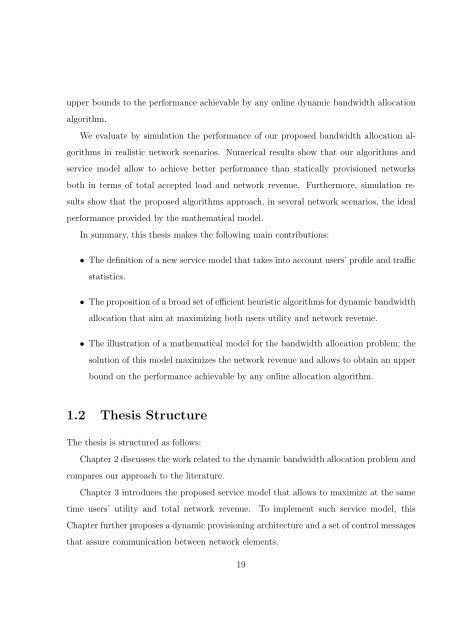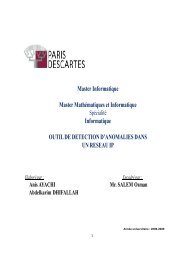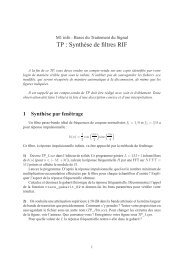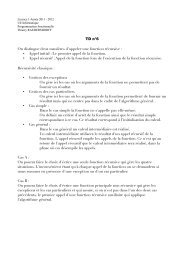Th`ese de Doctorat de l'université Paris VI Pierre et Marie Curie Mlle ...
Th`ese de Doctorat de l'université Paris VI Pierre et Marie Curie Mlle ...
Th`ese de Doctorat de l'université Paris VI Pierre et Marie Curie Mlle ...
Create successful ePaper yourself
Turn your PDF publications into a flip-book with our unique Google optimized e-Paper software.
upper bounds to the performance achievable by any online dynamic bandwidth allocation<br />
algorithm.<br />
We evaluate by simulation the performance of our proposed bandwidth allocation al-<br />
gorithms in realistic n<strong>et</strong>work scenarios. Numerical results show that our algorithms and<br />
service mo<strong>de</strong>l allow to achieve b<strong>et</strong>ter performance than statically provisioned n<strong>et</strong>works<br />
both in terms of total accepted load and n<strong>et</strong>work revenue. Furthermore, simulation re-<br />
sults show that the proposed algorithms approach, in several n<strong>et</strong>work scenarios, the i<strong>de</strong>al<br />
performance provi<strong>de</strong>d by the mathematical mo<strong>de</strong>l.<br />
In summary, this thesis makes the following main contributions:<br />
• The <strong>de</strong>finition of a new service mo<strong>de</strong>l that takes into account users’ profile and traffic<br />
statistics.<br />
• The proposition of a broad s<strong>et</strong> of efficient heuristic algorithms for dynamic bandwidth<br />
allocation that aim at maximizing both users utility and n<strong>et</strong>work revenue.<br />
• The illustration of a mathematical mo<strong>de</strong>l for the bandwidth allocation problem; the<br />
solution of this mo<strong>de</strong>l maximizes the n<strong>et</strong>work revenue and allows to obtain an upper<br />
bound on the performance achievable by any online allocation algorithm.<br />
1.2 Thesis Structure<br />
Th<strong>et</strong>hesisisstructuredasfollows:<br />
Chapter 2 discusses the work related to the dynamic bandwidth allocation problem and<br />
compares our approach to the literature.<br />
Chapter 3 introduces the proposed service mo<strong>de</strong>l that allows to maximize at the same<br />
time users’ utility and total n<strong>et</strong>work revenue. To implement such service mo<strong>de</strong>l, this<br />
Chapter further proposes a dynamic provisioning architecture and a s<strong>et</strong> of control messages<br />
that assure communication b<strong>et</strong>ween n<strong>et</strong>work elements.<br />
19










